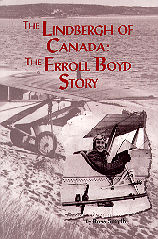


|
The Lindbergh of Canada: The Erroll Boyd Story.
Ross Smyth.
Subject Headings:
Grades 10 and up / Ages 15 and up.
**1/2 /4
|

excerpt:
The departure airport at Grace Harbour, Newfoundland holds a prominent spot in aviation history. Out of twenty transoceanic flights attempted from Grace Harbour in the 1926-1937 period, eleven were successful, four were unaccounted for, two crashed on take-off, two aborted their flights for various reasons, and one crashed off the coast of Ireland with the pilot being rescued ...The safety record for Grace Harbour was better than from many other departure points. In this adventurous era of the late 1920s and early 1930s many airmen and women were lost at sea. Not only were their aircraft, engines and instruments crude by present standards, but many of the crews lacked formal training in instrument flying. The probable cause of the many disappearances at sea was loss of control at night in the turbulent conditions causing a deadly spiral dive with possible structural failure.
To American author Tom Wolfe, the jet test-pilots of the 1960's and the original astronauts of the Mercury space program were made of the "right stuff". In the 1990's, the pilots of the F-18s, Stealth Fighters, and Harrier jump-jets became the "Top Guns" youthful aficionados want to emulate.
Canadian Erroll Boyd and his fellow "fly by seat of your pants" adventurers of the 1920's and 1930's did not have the massive government and corporate supports pilots have today. They only had courage, daring, and, more often than not, foolish bravado. Smyth's statistics of trans-Atlantic flights record that, of the 90 airplanes that tried to cross prior to 1937, only 13 got to where they were going, 30 got across some way, and 41 flyers lost their lives.
These men and women deserve proper historical recognition for their efforts. Boyd, a pioneering world record holder for long distance flights, has never been cited in the Canadian Who's Who, and his accomplishments are not mentioned in standard Canadian encyclopedias. It seems that until Smyth wrote this book, Boyd was a forgotten man in Canada.
Erroll Boyd once said, "Flying gets a hold of you and you can't keep away from it." It got hold of 20-year-old Erroll in 1912 and never let him go until his death in 1960. He received his World War I pilot training from Sir John Alcock, who, in 1919, became the first British pilot to fly non-stop across the Atlantic. In 1930, Erroll became the second British citizen and first Canadian to fly across the Atlantic.
He flew his plane, the Columbia, which, next to Charles Lindbergh's Spirit of St. Louis, was the most famous plane of the decade, across the Atlantic on his first world record, a New York-Bermuda non-stop/return flight and then on a world record Washington-Haiti non-stop/return flight. Columbia was unfortunately destroyed in a fire in 1934.
Boyd knew all the greats of aviation's first generation of trans-Atlantic, long distance, and military fliers: Howard Hughes, Charles Lindbergh, Amelia Earhart, Jimmy Dolittle, Billy Bishop and Claire Chenault. Like them, he was feted by the famous, lauded in the popular press, and had parades down main streets in his honour.
However, as Smyth tells the story, Boyd's fame did not translate into fortune; virtually all the prize money he collected went to pay the flights' heavy debts, a common occurrence among many of the early fliers whose only residual wealth consisted of memories of past glories.
Boyd was a dreamer, a promoter and, perhaps, even a bit of a scamp. He had a remarkable zest for life. He wrote songs and one, Dreamer, even became a popular hit in the 1920's. He was an early type of paparazzi and had a taste for gin. Even though there always seemed to be new adventures on the horizon and new companies with which to work, Boyd had little success after 1930. While the bailiff was not a stranger at the family's door, the Boyd's got through the hard parts and, it seems, had a pretty good time after all.
In 1940, his father wrote him, "For a man with some good brains, you continue to sell them for a poor income. Why so silly?" That's often the down-side of following dreams: no money; no security; no respect.
However, Smyth leaves it to his readers to decide whether Erroll Boyd made the better trade.
Recommended.
Ian Stewart, a Winnipeg Public Library Trustee and regular CM reviewer, also reviews for other Canadian publications.

To comment on this title or this review, send mail to cm@umanitoba.ca.
Copyright © 1997 the Manitoba Library Association. Reproduction for personal use is permitted only if this copyright notice is maintained. Any other reproduction is prohibited without permission.
Published by
The Manitoba Library Association
ISSN 1201-9364
TABLE OF CONTENTS FOR THIS ISSUE - OCTOBER 17, 1997.
AUTHORS | TITLES | MEDIA REVIEWS | BOOKSHELF | BACK ISSUES | SEARCH | CMARCHIVE | HOME